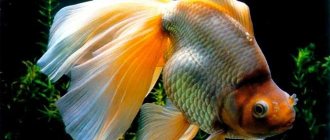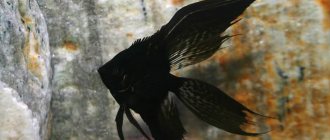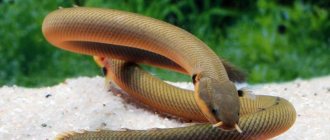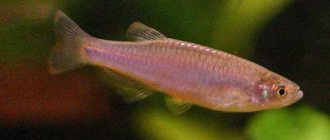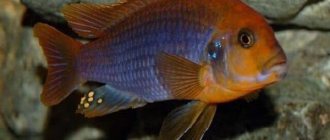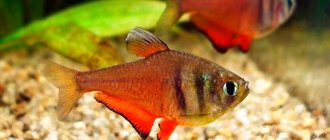One of the beautiful inhabitants of Malawian cichlids is the colorful kadango fish. Amazing morals, behavior, character and, of course, unique body coloring make this fish a welcome guest in any aquarium.
Kadango are endemic to Africa's Lake Malawi. They live near the coast in open water or near a pile of large boulders at a shallow depth of up to 5 meters.
Latin name: Copadichromis borleyi Kadango.
Russian name: Copadichromis kadango.
Alternative names: Haplochromis kadango, red kadango, catango.
Water parameters for keeping kadango
The same as for all Malawian cichlids.
- temperature 24-28°,
— hardness dH 5-20°,
— acidity pH 7.0-9.0.
Filtration, aeration and weekly replacement of aquarium water with fresh water are required.
Description
Kadango fish have distinctive external characteristics. The main ones are:
- a classically shaped body characterized by smooth curved lines;
- large head with large jaw;
- red-blue, gold-blue, orange-blue body color;
- elongated pelvic fins.
Copadichromis kadango belongs to the Utaka group of the Cichlid family. In captivity, males can reach a length of 15 cm, and females - 10. Inexperienced breeders often ask how long fish live at home. With proper maintenance and care, their life expectancy can be 10 years.
Compatibility with other fish
The character of Copadichromis kadango can be called relatively peaceful. Can be kept with other species of Malawian cichlids, provided they are of opposite coloration, proportionality and sufficient space in the aquarium.
Despite the fact that their jaws are not adapted for killing, during the pre-spawning period they can cause serious injury to a competitor on the female’s heart. During this period, hostility within the species and even towards the female is possible.
The rest of the time the character is calm and peaceful. In a spacious aquarium it will be a good neighbor for fish with a similar habitat.
How to properly care for fish?
Caring for red kadango is quite simple. The first and mandatory condition that must be met is the acquisition of a large, spacious aquarium. Its minimum capacity should be 300 liters. When arranging a container, it is important to consider the following water parameters:
- hardness (dH) – 5-20°;
- acidity (pH) – 7-9°;
- temperature – 24-28°C.
A sandy substrate would be an excellent soil option. It is necessary to place several flat stones on the bottom of the container. One of the areas of the space should be decorated with a pile of boulders or rocks. Plants in an aquarium with red kadangos are optional.
It is important for the described individuals to constantly have access to fresh air, and therefore it is worth installing powerful cleaning filters and devices that promote water aeration. The lighting should not be too bright. A change of 10-20% of the water mass must be carried out once a week.
Maintenance and care, arrangement of the aquarium
The Red Kadango requires significant swimming space. The minimum volume of an aquarium for a group of 3-4 fish should start from 300 liters. The design uses a sandy substrate, piles of stones, and rock fragments. A good addition would be an artificial three-dimensional background that imitates a rocky shore.
Live plants are optional. If desired, it is permissible to place several species that can grow in an alkaline environment. For example, Vallisneria, some Anubias, Arrowhead, as well as numerous mosses and ferns.
The water of Lake Nyasa has a stable hydrochemical composition with high pH and dGH values. Such conditions must be ensured for long-term maintenance. It is unacceptable for fish to be in soft, slightly acidic water.
High quality water is achieved by updating it weekly by 10–20% of the tank volume while simultaneously cleaning the soil from organic waste (uneaten food residues, excrement, etc.). The installation of a productive filtration system serves the same purpose. The higher its efficiency, the less maintenance effort will be required from the aquarist. Professional filters will allow you to make the necessary water changes much less frequently without damaging the aquarium’s biosystem. The minimum required set of equipment, in addition to the filter, includes a heating, lighting and aeration system.
Feeding
Under natural conditions, fish eat zooplankton, small crustaceans that usually drift in the water column. At home, it is recommended to use food rich in protein. These include both dry and frozen, live, homemade mixes. It is important that the fish’s diet be varied, and therefore it is worth diluting the regular diet with vegetable crops. There is no need to worry that kadangos will not chew the offered pieces of lettuce or cucumber, as they have quite large and strong jaws. Feeding the fish should occur a maximum of twice a day.
Nutrition
In a home aquarium, most foods will be accepted in dry, frozen and live form. The daily diet may consist of flakes, granules with the addition (if possible) of brine shrimp, bloodworms, large daphnia and other small invertebrates.
Our product Aqvium natural dry food for small and medium fish from clean lakes of Siberia and Northern Crimea in environmentally friendly biodegradable packaging.
Find out more
It is important that the feed contains a certain amount of plant components for a balanced diet.
Sex differences
Inexperienced breeders always wonder how to determine the sex of the purchased individual. Distinctive features of Copadichromis cadango males are:
- the presence of elongated ventral fins;
- bright red-blue color.
Most often, females are smaller in size and pale in color. Determining which genus of the Cichlov family this or that “girl” belongs to is not so easy, because they are all similar to each other. However, sexual differences are very pronounced, and therefore choosing a male and several females for an aquarium is not difficult.
Behavior
A relatively peaceful species, aggression manifests itself only during spawning, so it can be kept with other calm species of cichlids. As a recommendation, when selecting a mate, choose fish of similar size and opposite coloration to minimize the risk of aggression during mating season. Males may view similarly colored fish as competition. Also, you should not keep two male Kadangos in one aquarium; the best option is a harem with one male and 3-4 females. It is not permissible to combine with aggressive and/or territorial fish.
Breeding and reproduction
If kadangos are properly maintained, they reproduce quite easily in captivity. To breed them, it is important to comply with several conditions:
- placing a black flat stone on which spawning will take place (it is a known fact that fish have a love for dark matte surfaces);
- a sharp decrease in water temperature to 24°C, and then an increase to 28°;
- increasing the proportion of live food in the diet before spawning.
Unlike rainbow cichlases, rainbow cadangos do not form permanent pairs. Females spawn on flat black surfaces or in holes that are prepared in advance by males. Typically a litter consists of 60-70 eggs. It is important that the water temperature is normal during the breeding season.
After the male fertilizes the eggs, the female swallows them along with water masses and holds them in her mouth during the entire incubation period. It usually lasts for three weeks. After the grown fry get into the aquarium, they stay in a school. The first feeding of the “babies” is carried out on the second day after their appearance in the general aquarium. Crushed dry food will do.
Red cadango or copadichromis cadango Copadichromis borleyi
12275
Copadichromis kadango video
Copadichromis kadango is an endemic species of Lake Malawi in Africa. Representatives of this species of cichlids are found in the southern part of Lake Malawi (state of Malawi) near the settlement of Kadango and at the Crocodile Rocks. Kodango belongs to the Utaka group of cichlids. In Lake Malawi they live near the coast at depths of 5 to 20 meters, females and juveniles can form large schools of several hundred or even thousands of individuals that swim and feed in open water near large boulders, dominant males are territorial and zealously guard their territories on the boulders themselves.
Copadichromis Kadango has a classic cichlid body shape with smooth curved lines. Its head is quite large with a large jaw, allowing it to swallow a large portion of water with plankton contained in it.
There are several color variations of kadango. The most popular form has a red-brown body and blue head and fins. Also common is a variation in gold or orange body color with three dark spots, the head and fins are blue, the anal fin is yellow with speckles. Females and juveniles are noticeably inferior to males in the richness of colors; they are usually gray or silver with yellow fins. The average size of adult males reaches 15-17 cm, females are slightly smaller.
In nature, Copadichromis kadango feeds on zooplankton, consisting of small crustaceans drifting in the water column. In the aquarium, it is necessary to adhere to the same diet: brine shrimp, cyclops, daphnia, shrimp, preferably feeding on small crustaceans, high-quality dry food. A certain amount of herbal supplements, such as spirulina flakes, is a must. Red Kadango requires significant swimming space, especially if there is a small school of these fish. The minimum tank volume should be 300 liters. The design uses a sandy substrate with several flat stones at the bottom. In one of the areas, place a structure made of a pile of boulders or rocks. The water of Lake Malawi is distinguished by its stable composition and is slightly alkaline; similar water parameters must be observed in the aquarium. Although the Kadango is a relatively peaceful species, a group of two males and 5-6 females can be kept in a large aquarium.
These cichlids reach sexual maturity at the age of 10-12 months. During the spawning period, male kadangos become aggressive. These fish can spawn in a community aquarium. Males determine the future spawning site at the base of boulders and clear it of debris. Each female lays up to 60 eggs, which are immediately placed in the mouth. An equally interesting method is used for fertilization. Each male has a pattern on the anal fin of bright contrasting dots, reminiscent of eggs, which are mistakenly perceived by females as real. When she tries to take them, the male releases the seed and fertilization occurs. The entire incubation period (it lasts 3–4 weeks) the eggs are in the female’s mouth.
Kinds
Striped platidoras
Initially, the striped catfish was called Platydoras costatus, but about 12 years ago a group of biologists created a classification of species by habitat. Based on this, the species includes catfish that live in rivers in eastern South America.
Raphael's striped catfish
Platydoras, which is distributed throughout the country, is called Raphael's striped catfish. This type has been available in stores for many years and is the most well known.
Platidoras brachylesis
This species is found in the rivers of northeastern Brazil. It is distinguished by a light yellow line along the body, which runs strictly in the center, from the head to the end of the caudal fin; the rays of the remaining fins are also colored yellow. The area on the side behind the pectoral fins is darkened.
How long do cichlids live and how to determine their age?
African cichlids live for about 10 years. The lifespan of any living organisms, in particular fish, directly depends on their habitat and the temperature of the aquarium water in which they are kept. With increasing temperature, the biorhythm and metabolism of fish also increases. Simply put, the cooler the water, the longer the fish live. You can find out how long other fish live
It is also worth noting that the lifespan is also affected by the conditions of detention, such as, for example, the size of the aquarium, water parameters, as well as the presence of poisons in the aquarium - nitrogen compounds: NH4, NO2, NO3. Naturally, fish do not live long in unfavorable conditions.
How to determine the age of cichlids? Most aquarists do not breed fish and buy them at pet stores, which is why difficulties arise in determining the age of the pet. But you want to know the age of the fish!? In this regard, it is worth noting that, as a rule, pet stores sell teenagers - juvenile fish, aged 2-5 months. In addition, it is worth focusing on the physiological signs of the fish. The following will help determine age: size, color, sexual characteristics.
Most fish develop color during the first months of life, that is, fry, as a rule, have a pale color, and adults are brightly saturated. The same goes for size, compare the size of an adult with the specimen that swims in your aquarium
In addition, you should pay attention to the sexual characteristics of the fish; they, like the color, are formed in the fish gradually - this is expressed in the degree of color of the males, the formation of a fatty bump on the forehead of most male cichlids, the sharpening of the fins in males (for example, in gourami), the growth of the sword in male swordtails, the formation of a chic veiled tail in male guppies, etc.
Subscribe to our YouTube channel so you don't miss anything
Below is a small list of cichlids.
South American cichlids: Apistogramma About 65 species. Size - up to 12cm. Apistogrammoides Size - up to 4 cm. Biotoecus Size - up to 8cm. Biotodoma Size - up to 12cm. Cleithracara Size - up to 8cm. Crenicara Size - up to 12cm. Dicrossus Size - up to 6cm. Guianacara Size - up to 12cm. Laetacara Size - up to 10cm. Mazarunia Size - up to 6cm. Mikrogeophagus Size - up to 8 cm. Nannacara Size - up to 8cm. Taeniacara Size - up to 4 cm. Tahuantinsuyoa Size - up to 12cm. Teleocichla Size - up to 7cm.
From Africa: Anomalochromis Size - up to 6 cm. Benitochromis Size - up to 12cm. Chromidotilapia Size - up to 12cm. Divandu Size - up to 12cm. Etia Size - up to 14cm. Gobiocichla Size - up to 8cm. Limbochromis Size - up to 8cm. Nanochromis Size - up to 7cm. Parananochromis Size - up to 11cm. Pelmatochromis Size - up to 14cm. Pelvicachromis Size - up to 12cm. Steatocranus Size - up to 11cm. Teleogramma Size - up to 10cm. Thysochromis Size - up to 9cm.
Photos of cichlids
We hope that the article turned out to be interesting. Although we understand that you can’t say everything. The best knowledge is individual experience. Cichlids are beautiful fish, interesting, smart fish! Don't be afraid of them. Start with small peaceful cichlids, look around, and lo and behold, in a year or two you will have both acara and astronotus!
Video about aquarium cichlids
+
Subscribe to our YouTube channel so you don't miss anything
Category: Aquarium articles / Useful tips for keeping fish | 801 | Date: 28-01-2014, 16:47 |
Editorial: Schubert Barbus
We also recommend reading:
- — Aquarium frogs: types and compatibility with fish
- — Aquarium filters: types of filtration, which one to choose, photo-video review
- — Aquarium turtles: popular species and their compatibility with fish
- - Helena - aquarium predator
- — Aquarium for beginners!
Content
Rhodostomus is a schooling fish.
Therefore, you will need an aquarium of 50 liters or more. In nature, fish live in densely overgrown areas, so a large number of plants will be required. The red-nosed tetra naturally lives in densely overgrown bodies of water, so the aquarium needs to be densely planted with plants.
These are demanding pets. The most comfortable conditions for them are those that are as close to natural as possible. The water should be soft and acidic with an already established balance. If at least one parameter is unsuitable, rhodostomuses lose their brightness and color. Stress can also cause color loss, for example after purchasing and placing fish in a new aquarium.
It will require cleanliness, a certain temperature within 23-25 degrees Celsius, filtration and aeration. It is also necessary to monitor the concentration of nitrates and ammonia in the water, since fish are extremely sensitive to the composition. Every week you should replace a quarter of the water with fresh water.
Any live or frozen food is suitable as food for Rhodostomus. You can give flakes after crushing them. Nutrition must be balanced, because the brightness of the color of the fish directly depends on it. Dry food is not recommended, as it adversely affects the general condition of animals. It is better to add plant foods to your diet. The fish happily eat small worms, granules, flakes, shrimp, and raw fish fillets. You can feed no more than twice a day in small portions.
As for light, tetras do not like strong lighting. They prefer to hide in the shade of plants or shelters at the bottom. Therefore, the light is chosen based on the requirements for the plant component of the aquarium.
Coarse and medium sand and artificial stone without sharp corners are suitable as soil. It is advisable to decorate the bottom with large stones and driftwood, making grottoes and caves out of them.
Nutrition must be balanced, because the brightness of the color of the fish directly depends on it.
Rhodostomus has strong immunity. However, if maintained poorly, various diseases can occur. For example, the lack of quarantine and treatment for new pets, vegetation, soil (especially from another aquarium) and decor can lead to infection or fungi.
First, the disease affects one or several individuals at once. If neighboring fish are in poor health, the problem may spread throughout the entire aquarium.
As a rule, Rhodostomus is susceptible to infection:
- Parasites;
- Bacteria;
- Infections.
At the slightest deviation in fish behavior from the norm, it is necessary to quarantine the sick individual. After which, the symptoms, the disease itself are established and treatment is prescribed.
Content
Microrasboras are fairly unpretentious aquarium fish, however, they also need to create appropriate conditions that are as close as possible to natural ones, namely:
Aquarium. The minimum volume is 30 liters, but, naturally, the more, the better. Ideally, you need to purchase about 20 individuals. It is in large flocks that these creatures feel most comfortable. However, it is worth considering that clashes can occur between males, and non-dominant individuals need to hide somewhere. That is, the aquarist must create several hiding places;
Vegetation. In the nature of microrasbora, the galaxy lives in overgrown streams and rivers. Therefore, it is necessary to recreate a similar environment in the aquarium. You can use any plants, since these fish are not capable of harming underwater flora. But, of course, it is better to choose vegetation from the same region;
Water parameters. The microrasbora galaxy prefers warmth. The optimal temperature is 22-28°C, acidity is about 7 pH, hardness is average, about 8°. But what is much more important is not the parameters themselves, but the purity of the water. In nature, these animals live in bodies of water where there is a constant flow, and abundant thickets serve as an excellent filter. Therefore, to successfully maintain them, you definitely need good equipment, a variety of plants and weekly water changes of at least 25-30% of the total volume;
Lighting. The ideal option is a powerful LED lamp. Firstly, it is well suited for dense vegetation, and secondly, microrasboras are accustomed to bright sunny days;
Microassembly galaxy is ideal for a nano aquarium or shrimp tank.
Feeding. Regarding their diet, these animals are unpretentious. They are suitable for both plant and meat food. Therefore, they can be given dry flakes, bloodworms, daphnia, brine shrimp, tubifex, koretra and many other foods. The main thing is that the diet is varied and includes all the necessary vitamins and nutrients. Well, of course, it is worth considering that microrasboras grow small, and therefore large food is not suitable for them;
Compatible with other fish. Often these representatives of the underwater fauna are kept in species aquariums, since it is much easier to spawn. Well, and besides, they are usually kept in nano-aquariums, which by default cannot accommodate many individuals. But if you still want to hook someone and have a larger container at hand, then the same small fish with a peaceful character will become ideal neighbors. For example, guppies, rasboras, danios, neons, cardinals, cherry barbs, etc.;
Priming. He can be anything. The main thing is that it is suitable for the chosen vegetation. It is best to purchase quartz, fine pebbles or even sand.
It is worth mentioning separately about diseases in these fish. With improper care and contaminated water, they can contract a bacterial infection. In addition, these pets are prone to obesity, so they should not be overfed. In cold water they can develop a fungal disease. They are also prone to oodinosis, for which it is necessary to use the drug bicillin-5.
How to identify the problem?
Brown algae appears as a brown or brownish coating that covers everything in the aquarium. Some people confuse them with sea browns (kelp is one of them), but they are different species. However, they contaminate the container, causing more harm than good.
Brown algae appears as a brown or brownish coating that covers everything in the aquarium.
At first, the plaque is difficult to notice, since it does not yet have such a bright and rich color. Over time it becomes thicker and more visible.
Removing tumors is easy. It is enough to clean the walls of the aquarium with a special scraper, shake the leaves and branches of plants and wipe the decorations with a damp cloth (or rinse them in running water).
If diatoms have grown throughout the entire container, you will have to spend much more time. Now it’s no longer possible to chicken out, because the old layer fits tightly to the surface, blocking the plants’ access to light. The process of photosynthesis is disrupted and the leaves begin to die. The presence of algae also negatively affects fish, which do not receive enough nutrients from the water necessary for normal life. Thus, brown algae in an advanced stage threatens the entire living population of the aquarium.
Diseases and their prevention
Blue dolphins, although they are aquarium fish, are unfortunately not immune to various diseases. It is good to take into account that the owner’s attentiveness prevents complications of the disease, because almost all diseases can be cured in the early stages.
To prevent the development of serious infectious and cold-related diseases in fish, it is important to use prevention: clean the aquarium weekly, prevent foreign objects from entering the aquarium, maintain a diet and the desired temperature. In the event that it was not possible to avoid the disease, it is important to clarify its type and immediately begin treatment
In the event that it was not possible to avoid the disease, it is important to clarify its type and immediately begin treatment. Let's look at the often recorded diseases of the blue dolphin:
Let's look at the often recorded diseases of the blue dolphin:
When consuming low quality feed, inflammation of the gastrointestinal tract occurs. The consequences are the death of pets, usually juveniles. Signs: the abdomen is inflated, redness in the anal fissure area, constipation or the release of excrement with undigested food, heavy breathing, refusal to eat, passivity. Treatment: restore the correct housing environment, ensuring the requirements for sanitation, air exchange, heat and water changes. At the end of the fast (two to three days), provide small doses of food - live food (crustaceans - daphnia, cyclops), fresh coretra.
It must be remembered that poisoning of fish, sources of intoxication, the entry of toxic elements into the inside of the fish when eating spoiled food, as well as ingestion of poisoned tank water, are dangerous. Signs: convulsive movements, lack of orientation of the fish, faded color. Measures: immediately place the fish in a vessel with purified water, arrange all the necessary optimal conditions to maintain the water in the required condition, carefully clean the aquarium grass in tap water, and also pass the soil through the water.
Fish colds develop after serious cooling, for example, when transporting fish in cool weather without insulation, placing the aquarium near a window, lack of heating, or malfunction of the electric heater. Fish exposed to a cold are inactive, the body color fades, the fish are covered with gray mucus with the development of inflammation of the gills. The consequence of the disease is a decrease in the immunity of fish and, as a result, the most likely infection of weakened individuals by infectious diseases. Sick fish need to be provided with exemplary living conditions and a speedy recovery: warm water, air exchange, easily digestible food.
Ulcerative disease - appears in a reservoir with natural food, water, soil, plants and diseased fish specimens. The body of infected fish has small ulcers, which without treatment can grow and penetrate inside. For treatment, solutions of potassium permanganate and trypaflavin are used.
Also, infectious diseases are common among blue dolphins, resulting from the use of stale, poor food, or their long stay in “old” water. To eliminate the risk of infection of aquarium inhabitants, you should add kitchen salt, trypaflavin, and rivanol in therapeutic doses.
Editorial: Echinodorus schluthera
Breeding and caring for the blue beauty from Malawi is a labor-intensive task that requires effort and skill, but isn’t the result worth it? Make the effort to acquire the necessary skills and experience, and you will enjoy blue dolphins for many years to come.
